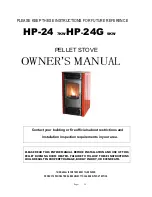
A
C
B
ENGLISH
Air inlet
REFERENCES
INFLAMMABLE OBJECTS
NON-INFLAMMABLE OBJECTS
A
200 mm
100 mm
B
1500 mm
750 mm
C
200 mm
100 mm
floor protection
INSTALLING INSERTS
When installing inserts, access must be prevented to the internal parts of the appliance and it must not be possible to access live parts during
extraction operations.
Any wiring, for example the power cable or room probe, must be positioned so as not to be damaged during movement of the insert and
must not come into contact with hot parts.
VENTILATION AND AERATION OF THE INSTALLATION PREMISES
Ventilation is deemed sufficient when the room is equipped with air inlets according to the table:
Appliance categories
Reference standard
Percentage of the
net opening section with respect to the
appliance fumes outlet section
Minimum net opening value of the
ventilation duct
Pellet stoves
UNI EN 14785
-
80 cm²
Boilers
UNI EN 303-5
50%
100 cm²
In any case ventilation is deemed sufficient when the pressure difference between the external and internal environment is equal to or less
than 4 Pa.
INSTALLATION
GENERAL
The flue gas exhaust and hydraulic connections must be carried out by qualified personnel who must issue installation conformity
documentation compliant with national standards.
The installer must provide the owner or person acting for him, according to the legislation in force, with the declaration of conformity,
supplied with:
1) the use and maintenance manual of the appliance and of the system components (such as for example, the smoke ducts, chimney, etc.);
2) photocopy or photograph of the chimney plaque;
3) system booklet (where applicable).
The installer must ask to be issued with a receipt stating that the documentation has been provided, and must keep it with a copy of the technical
documentation relating to the installation.
For installation in a condominium, prior approval from the condominium's administrator must be requested.
Where required, check the exhaust gas emissions after installation. Should a sampling point be installed, it must be airtight.
COMPATIBILITY
Installation in premises with fire hazards is forbidden. Installation in residential premises (except for sealed operation appliances) is also forbidden:
in which there are liquid fuel-operated appliances with continuous or intermittent operation, which draw the combustion air in the
room in which they are installed, or
in which there are type B gas appliances intended for room heating, with or without production of domestic hot water and in adjacent
and adjoining premises, or
in which, in any case, the depression measured during installation between the internal and external environment is greater than 4 Pa
INSTALLATIONS IN BATHROOMS, BEDROOMS AND STUDIO FLATS
Installation in bathrooms, bedrooms and studio flats is only allowed for sealed or closed hearth appliances with ducted combustion air taken
from the outside.
POSITIONING AND SAFETY DISTANCES
The support surfaces and/or points must have a suitable capacity to bear the overall weight
of the appliance, accessories and coverings. If the floor is made of a combustible material,
we recommending using a non-combustible material to protect the front part from any
burnt material which might fall during routine cleaning operations.
The generator must be level to function properly.
The adjacent, side and rear walls and the supporting surface must be made of non-
combustible material. Installation adjacent to combustible or heat sensitive materials is
allowed as long as there is a suitable safety distance in between, which for pellet stoves is:
39
















































